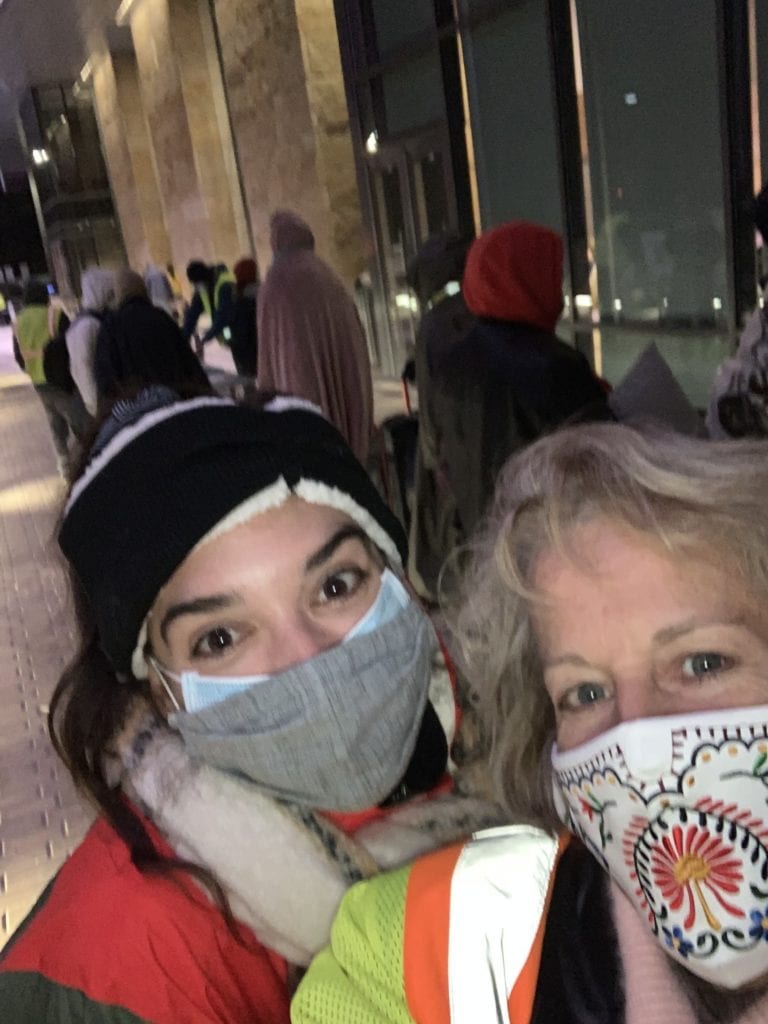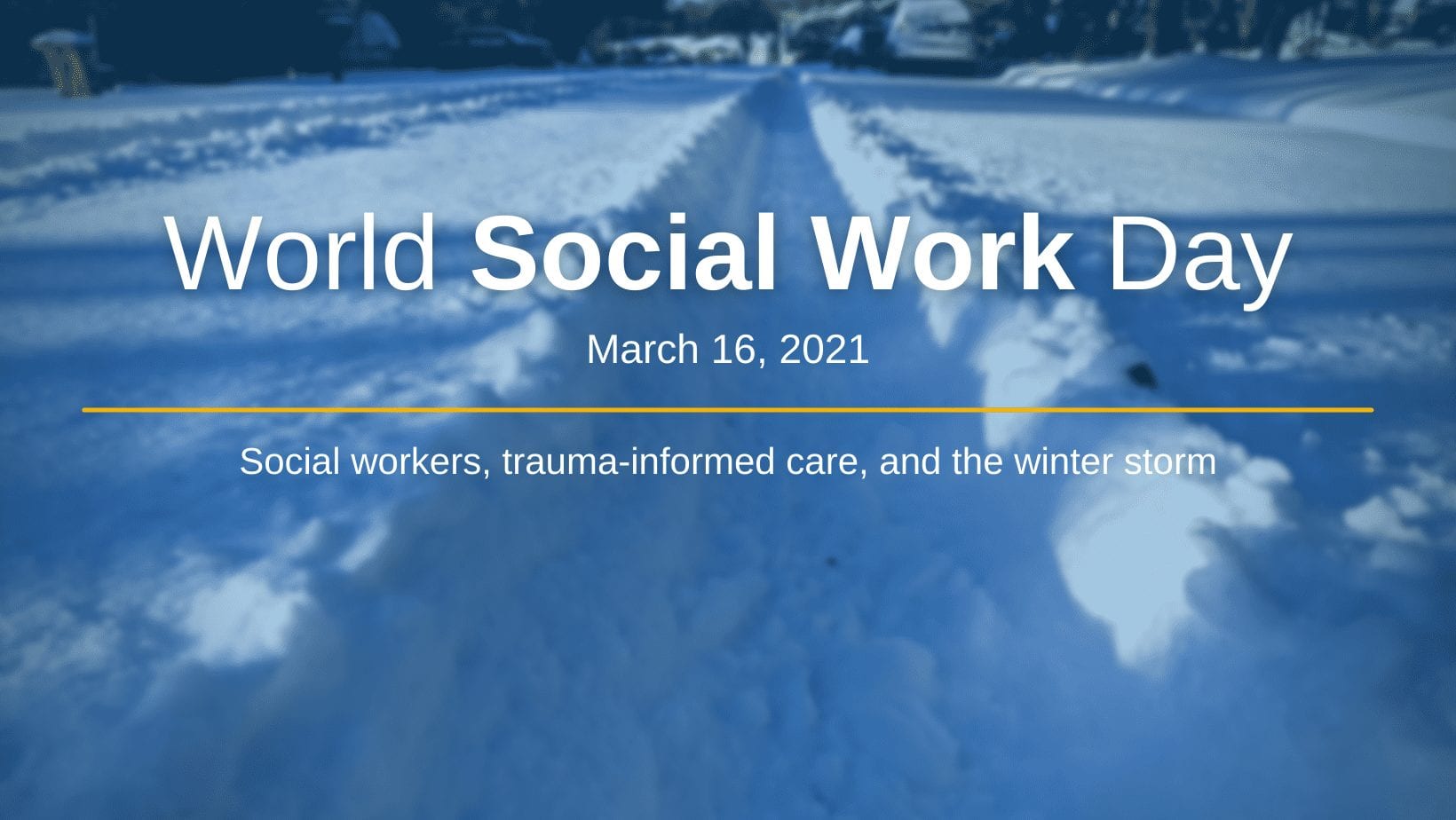Social workers, trauma-informed care, and the winter storm
AUSTIN, Texas (March 16, 2021) – As the bitter cold set in across Austin and Travis County on Valentine’s Day weekend, government and nonprofit leaders joined forces with a diverse range of direct service providers, social workers and community advocates to provide shelter, food, warm clothing, sleeping bags, and other necessities to people experiencing homelessness.
The winter storm and its aftermath represented a new type of traumatic event for Texans and especially for people already living with the daily traumas that come with living unsheltered in our community. Social workers and other frontline workers trained to use a trauma-informed care lens to support people during a natural disaster were critical to the crisis response for our unhoused neighbors during the freeze last month. Natural disasters can have a lasting impact on communities, and it’s not uncommon to see an increase in Post Traumatic Stress Disorder (PTSD) or other symptoms of anxiety and depression. Yet, when a community is able to come together to support the most vulnerable and impacted people, they feel a sense of safety, belonging, and connectedness that results in a stronger and more resilient community for everyone.
Two examples of this support and connection stand out: The City of Austin specifically recruited social workers to help people experiencing homelessness feel welcomed at the Palmer Events Center, respond to any mental health needs, and de-escalate crises and conflicts, while groups like Austin Mutual Aid demonstrated many best practices in terms of trauma-informed care by securing basic needs to feel safe during a historical natural disaster, providing hotel rooms, blankets, and other necessary resources for people experiencing homelessness.
Combined, these efforts helped our unhoused neighbors transition from the psychological security of their current circumstances to the physical safety of four walls during a traumatic and dangerous event. Many of the case managers, first responders, social workers, and volunteers risked their own safety to locate and transport people to warming centers and emergency shelters.
Regardless of any formal training or education, our community saw a true demonstration of the social work spirit and the values and ethics social workers live by.
ECHO is recognizing their contributions as we celebrate World Social Work Day today, March 16, and Social Work Month.
What is trauma-informed care?
Trauma-informed care (TIC) is not a new concept in the field of social work; trauma-informed service providers have long incorporated an understanding of trauma into their work. TIC is an approach that recognizes trauma triggers and responds to a person’s individual history of trauma and seeks to avoid retraumatizing that person during the course of the response.

Niki Kozak, MSW, ECHO’s Housing for Health Systems Manager, volunteered at Palmer during the storm, one of dozens of people who answered the City of Austin’s call for people with a social work background to help out. The City needed volunteers like Kozak because people experiencing homelessness often deal with complex trauma, whether it’s an experience with assault or sexual abuse from their past, a winter storm, or the effects of living in survival mode all day every day.
Trauma-informed care both recognizes this reality and provides a framework to respond with the resources individuals need to feel safe and secure, a key piece of building trust to ensure our unhoused neighbors receive the support they need. “We’re listening to the people and what they want,” Kozak says, “rather than us coming in and prescribing what we think they need.”
“Safety can look different for different people,” adds Laura Evanoff, LCSW-S, ECHO’s Director of Community Planning and Partnerships.
Best practices during the storm
A trauma-informed response was especially important during the winter storm, Evanoff says, because natural disasters are one of three broad types of trauma (along with manmade disasters and interpersonal violence). People tend not to focus on winter weather as natural disasters in a state that more often contends with tornadoes and hurricanes, but the effect of the weeklong storm aftermath is largely the same. Trauma-informed providers, whether social workers or any other community members, are critical in reducing the negative impacts by using key TIC themes, like trauma awareness, emphasis on safety, opportunities to rebuild control, and a strengths-based approach. These providers reinforce that they’re “going to be here regardless of what decision you make,” Evanoff says.
That’s why Kozak highlights the work of Austin Mutual Aid as an example of how to respond to traumatic situations. Volunteers approached hundreds of unhoused people to connect them to hotel rooms to stay safe and warm, but did not push specific interventions on anyone. Rather, they asked what the person needed if they declined a room, whether that meant providing blankets, food, water, clothing, or something else. The volunteers then provided those resources immediately.
And they didn’t just offer support once, but returned day after day to the same people to continue offering resources, a hallmark of trauma-informed care. “We heard from people experiencing homelessness that they felt people really cared about them because they kept bringing supplies,” Kozak says. “That kind of consistent support is the first step toward building a sense of safety and trust.” In some cases, she explained, people accepted a hotel room stay after two, three, or even five days of repeated visits.
Ongoing needs
Moving forward, social workers should ask people experiencing homelessness what they need to rebuild control and re-establish that sense of safety in their lives, Evanoff says. For people who are housed, rebuilding control after a natural disaster often takes the form of small measures like picking up branches from the yard or filling up a car with gas. For people who are unhoused, this might mean finding a place to charge a cell phone or thinking about what kinds of surroundings make them feel safest.
The Austin Homelessness Advisory Committee, a group of people who are currently or formerly experienced homelessness, put together this resource (PDF) filled with members’ examples of their coping skills. The examples include ways to find peace and safety in the middle of stressful or traumatic events.
Regardless of what makes people experiencing homelessness feel safe in the aftermath of a traumatic event, the most important thing social workers can do, Kozak and Evanoff agree, is keep showing up.


